


 |
April 19, 1995: A Visit to the Dallas Arboretum |
 |
March 11, 1995: We Celebrate Lowery's Birthday |
 |
Return to the Index for 1995 |
A few weeks ago, Fred and I saw an article in The Observer, a local newspaper, about the Dallas Zoo and some of the renovations that have been made and the new exhibits that have been opened. This Sunday, we thought that it was high time that we paid a visit to our city's Zoo. It has been eight years since I have visited the Zoo, and even longer since Fred has been there, so we thought it was time for another visit.
|
(I might point out that now, in 2015, it is a lot easier to get there. I could simply drive a mile down Inwood, park my car at the light rail station, and take the train to the Zoo. Although I wasn't a fan of all the money that was spent on the Dallas Light Rail System, it has made getting to the Fairgrounds and to the Zoo much easier. One day, it will make getting to the airport easier as well.)
The Dallas Zoo dates from the spring of 1888 when a man from Colorado City offered to sell two deer and two mountain lions to the City of Dallas. The animals were purchased by the City for $60 and placed in pens in City Park- the only city-owned park until 1904, when the City purchased Fair Park. Since the Zoo had outgrown City Park, in 1910 the entire collection moved to Fair Park, making it the second home of the Dallas Zoo.
The growing State Fair crowded the Zoo out, and in 1912 the Zoo moved to its current location- Marsalis Park in Oak Cliff. In 1922, a special zoo commission raised $10,000 for the zoo, and the number of animals increased from 161 in 1920 to 1,065 in 1925. One of the first major acquisitions, Queenie the elephant (d. 1955), was purchased with pennies, nickels and dimes donated by the schoolchildren of Dallas. The Zoo was upgraded in the late 1930s as a WPA project. It included an extensive system of concrete and natural stone bridges, park houses, winding walks, hillside stairways, and retaining walls along with new monkey cages, large animal dens and paddocks, and wild fowl cages. There was also a new building that served as both commissary offices and an entrance.
By the 1940s, the Dallas Zoo was one of the 10 largest zoos in the country, and in 1955, the Dallas Zoological Society was founded as a non-profit support group for the zoo to raise the necessary funds to purchase new animals for the collection.
|
A a long-range strategic plan and new funding led to a new chimpanzee habitat, a new children’s zoo, a new animal health care facility and new primate exhibits. Through the combination of private gifts and bond funds, the Zoo opened a lemur exhibit (1995), the Primate Place (1996) and the Kimberly-Clark Chimpanzee Forest (1997).
Again, I might note that the Zoo in 2015 is almost nothing like it was on our visit this year. Many new exhibits have been opened and new facilities constructed. Private funding increased significantly in the first decade of this century, and this has made the Dallas Zoo one of the premier attractions in the Southwest.
|
The first thing we wanted to do was take the tram ride through the African exhibit areas. On the way to the tram stop and this new portion of the park, we passed by the Elephant Fountain; being a "water feature", Fred wanted to get a picture of it.
We got to the tram stop, and had a short wait for it. The tram is actually a monorail that moves above the exhibit areas so you can see everything clearly. Each area is walled or fenced off from the others, and the monorail moves above and through them. Here is one such area containing, I believe, some African Antelope.
I have two pictures taken aboard the monorail as it moved through the African Savanna exhibit areas:
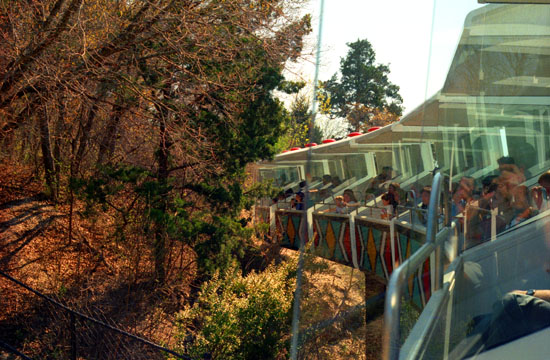 The monorail at the Dallas Zoo. This is one of the reasons that Fred thought a trip to the Zoo would be a good idea. The monorail and the African exhibits are a relatively new addition to the park and they have done a good job on it. |
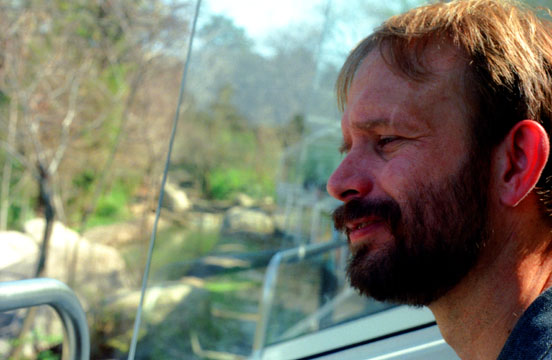 Fred aboard the monorail at the Dallas Zoo. At first I thought it unfortunate that I was so close to Fred that to get him in focus everything else had to be very out of focus, but after I saw the picture and thought about it, I think it is better this way. |
Here are two other pictures that we took while riding on the monorail tram through the African Savanna:
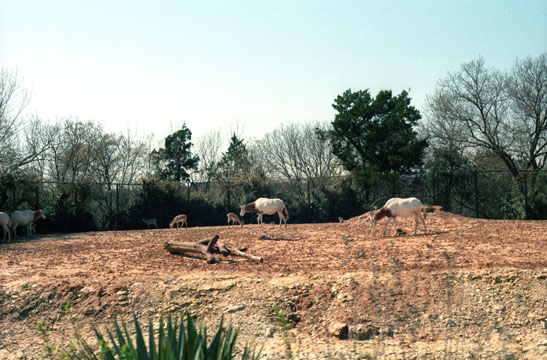 I'm not sure what all the animals were in this section of the African Savanna exhibit. Although the tram announcer told us, there was nothing for me to write the information down on. |
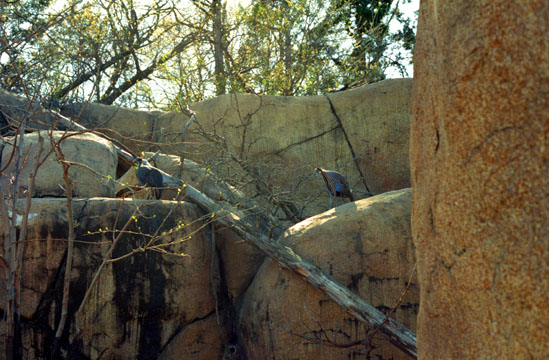 One of the enclosures we passed contained some large African birds. I must say that the tram ride was pretty neat, and a good way to see the individual areas of the exhibit. |
Once the tram/monorail got back to its station (after about 45 minutes, we got off and went on foot through some of the other exhibits in the African area of the park.
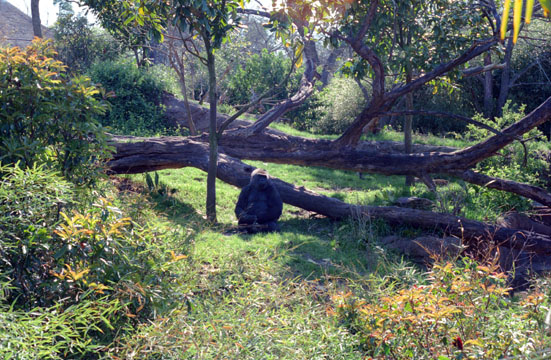 The gorillas are one of the prime exhibits at the Zoo; we saw three or four of them. This one stayed a good distance away from where the observation rooms and platforms are. I could not get close enough to use a flash to illuminate his features. |
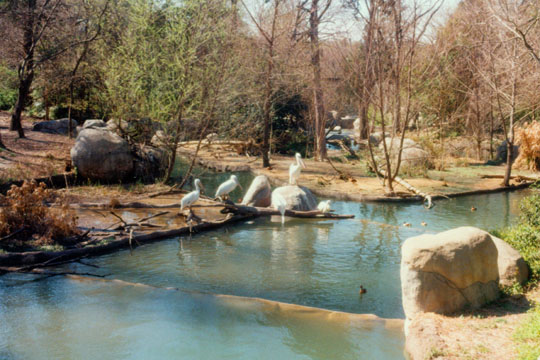 After we left the African exhibit area, we wandered off through the rest of the Zoo. The rest of the place is very much like your average Zoo, with lots of the animals that you would expect to see. One whole area seems to be open like this, and is filled with all kinds of birds. |
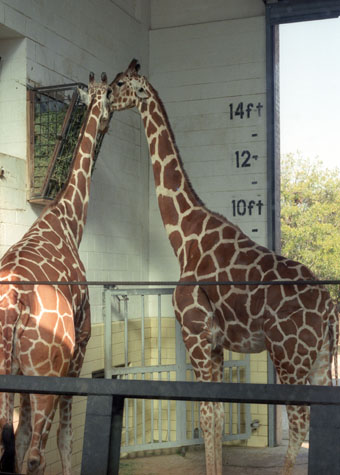 Giraffes at the Dallas Zoo |
(Picture at left) Some of the big animals, like the elephants and hippos and stuff, live in a large building, and each of their "stalls" has a door that leads to the outside area. I thought it was interesting that the door to the giraffe's area was so tall, and that it had markings alongside it so you could tell how tall the giraffe's were. It reminded me of what families do when their kids are growing up, as they put pencil marks along a door frame to track their increase in height. It was almost as if a set of giraffe parents had done the same thing. Also, I found it interesting that the feeding trough for the giraffes was so high on the wall.
(Picture at right)
|
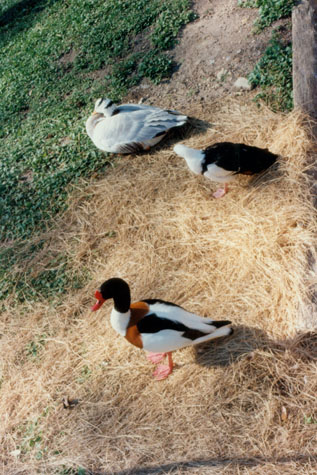 Unusual Birds at the Dallas Zoo |
We spent much of the rest of the afternoon just wandering along the pathways through the Zoo, stopping to have a look at whatever we thought to be interesting. We took four more pictures this afternoon, and they are below:
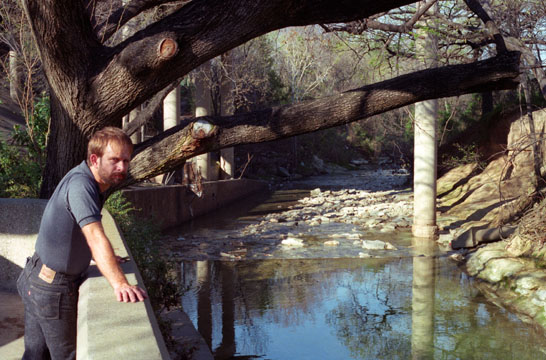 There is a small creek that runs alongside the Zoo. I'm pretty sure that the creek is natural, although it does help to form a barrier between the entryway to the Zoo and the exhibits proper. I thought that the gnarled tree out over the creek formed an interesting picture in the afternoon sunlight. |
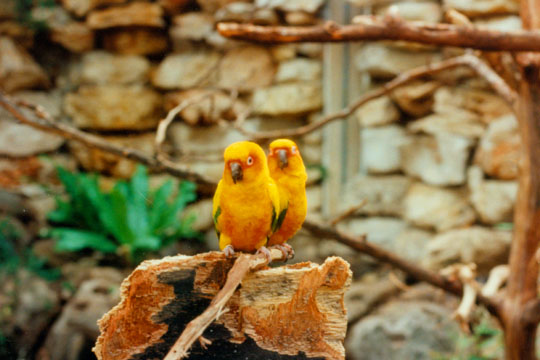 Down by the creek there is a very large free flight aviary. The aviary is a very large enclosed area that gives the birds a lot of room to fly around, but doesn't let them escape. There are also birds that apparently cannot fly, and these are simply allowed to wander around the grounds of the Zoo. I'm not sure how they are kept in the Zoo. |
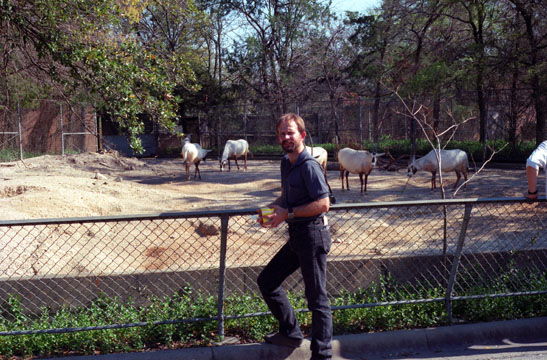 I'm not sure what the animals are; I guess I should have written it down. |
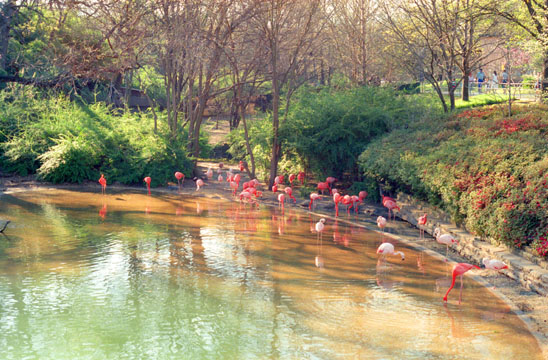 Here, there are lots of flamingos and egrets and other birds around the central pool which is pretty much right in the middle of the zoo. |
We had an interesting time at the Dallas Zoo. There are a lot of new exhibits planned, and new attractions as well, so we should come back more frequently than we do.
You can use the links below to continue to another photo album page.
 |
April 19, 1995: A Visit to the Dallas Arboretum |
 |
March 11, 1995: We Celebrate Lowery's Birthday |
 |
Return to the Index for 1995 |